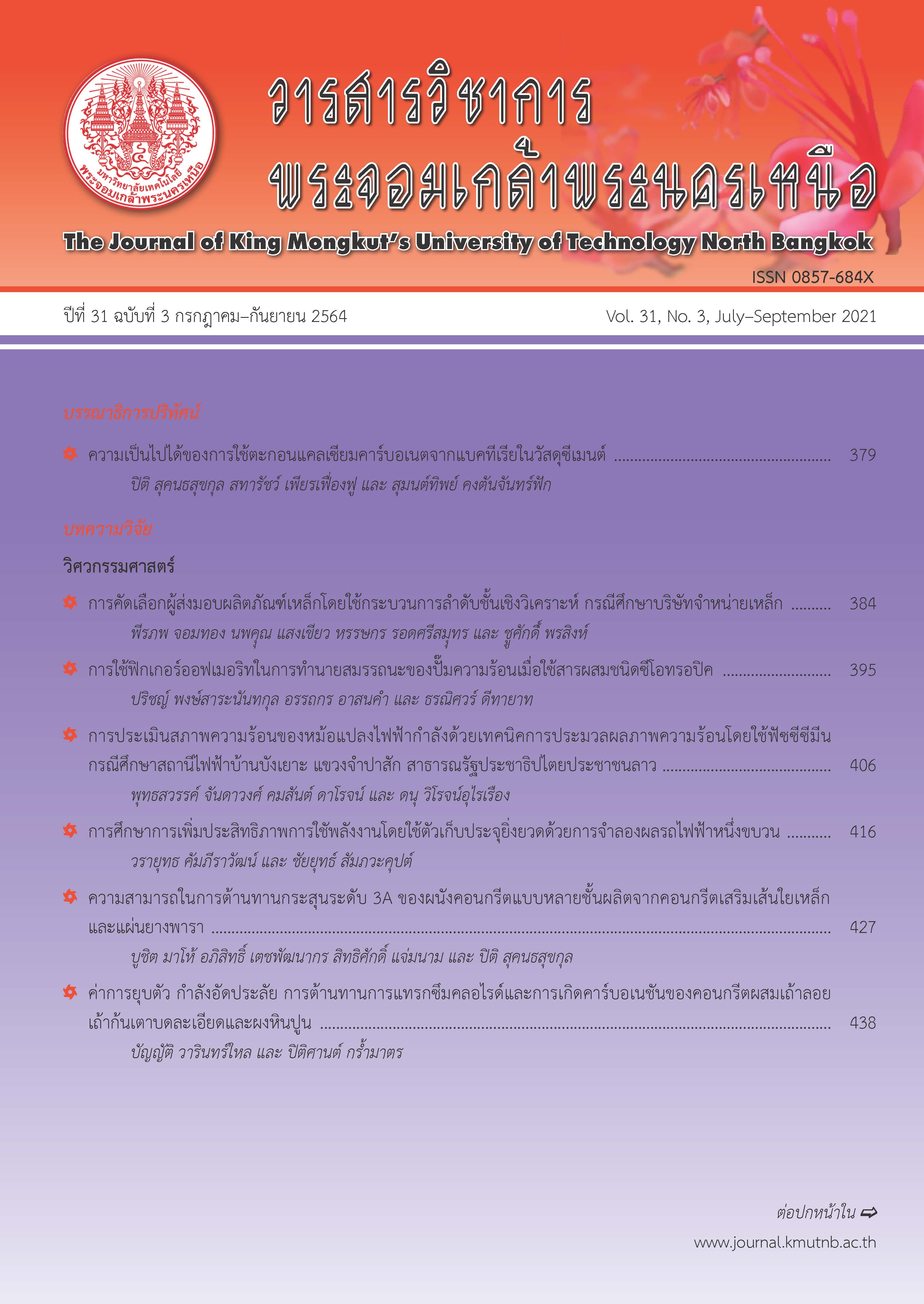การคัดเลือกผู้ส่งมอบผลิตภัณฑ์เหล็กโดยใช้กระบวนการลำดับชั้นเชิงวิเคราะห์ กรณีศึกษาบริษัทจำหน่ายเหล็ก
Main Article Content
บทคัดย่อ
งานวิจัยนี้มีวัตถุประสงค์เพื่อศึกษาเกณฑ์การตัดสินใจที่เกี่ยวกับการคัดเลือกผู้ส่งมอบผลิตภัณฑ์เหล็ก ด้วยกระบวนการลำดับชั้นเชิงวิเคราะห์ โดยเกณฑ์ที่ใช้ในการศึกษามี 5 เกณฑ์ คือ ราคา เงื่อนไขการชำระเงิน ระยะเวลาส่งมอบสินค้า การบริการ และคุณภาพ จากนั้นจึงใช้แบบสอบถามเป็นเครื่องมือในการเก็บรวบรวมข้อมูล ซึ่งแบบสอบถามได้รับการออกแบบ ได้ทำการตรวจสอบคุณภาพโดยวิธีการหาค่าดัชนีความสอดคล้องของวัตถุประสงค์ก่อนนำไปใช้งาน โดยผู้เชี่ยวชาญจะเป็นผู้ที่มีส่วนเกี่ยวข้องกับการตัดสินใจในการจัดซื้อผลิตภัณฑ์เหล็กจำนวน 6 คน ผลการวิจัยพบว่าคุณภาพมีความสำคัญมากที่สุด คิดเป็นร้อยละ 48.73 รองลงมาคือระยะเวลาการส่งมอบสินค้าคิดเป็นร้อยละ 18.86 ส่วนเกณฑ์ที่มีน้ำหนักความสำคัญน้อยที่สุดคือการบริการซึ่งมีน้ำหนักความสำคัญร้อยละ 7.72 และในด้านการคัดเลือกผู้ส่งมอบผลิตภัณฑ์เหล็กที่เหมาะสมที่สุด พบว่าผู้ส่งมอบ A มีน้ำหนักความสำคัญมากที่สุดคิดเป็นร้อยละ 43.63 รองลงมาคือผู้ส่งมอบ C มีน้ำหนักความสำคัญคิดเป็นร้อยละ 36.07 และผู้ส่งมอบ B มีน้ำหนักความสำคัญคิดเป็นร้อยละ 20.30 ตามลำดับ
Article Details
บทความที่ลงตีพิมพ์เป็นข้อคิดเห็นของผู้เขียนเท่านั้น
ผู้เขียนจะต้องเป็นผู้รับผิดชอบต่อผลทางกฎหมายใดๆ ที่อาจเกิดขึ้นจากบทความนั้น
เอกสารอ้างอิง
[2] M. Yogo, P. Lertkajornkitti, and J. Kunanoppadol, “Comparison of business model: A case study of steel store,” Silpakorn University Journal, vol. 36, no. 3, pp. 69–89, 2017 (in Thai).
[3] C. Chimabutr, “The factors affecting customer satisfaction in purchase of building meterials in retail stores and the adaptation of traditional building materials,” M.S. thesis, Faculty Economics, Thammasat University, 2015 (in Thai).
[4] N. Toomwangsa. (2018, September). Steel Industry. D.R. Industrial Co,Ltd. Bangkok, Thailand. [Online]. Available: https://www.krung sri.com/bank/getmedia/0ac57bbc-a283-411d-bf12-44996b0be1ca/IO_Steel_180903_TH_EX.aspx
[5] M. Giamalaki and T. Tsoutsos, “Sustainable siting of solar power installations in Mediterranean using a GIS/AHP approach,” Renewable Energy, vol. 141, pp. 64–75, 2019.
[6] A. E. Wolnowska and W. Konicki, “Multi-criterial analysis of oversize cargo transport through the city, using the AHP method,” Transportation Research Procedia, vol. 39, pp. 614–623, 2019.
[7] S. Kumar, F. Dweiri, S. Ahmed Khan, and V. Jain, “Designing an integrated AHP based decision support system for supplier selection in automotive industry,” Expert Systems With Applications, vol. 62, pp. 273–283, 2016.
[8] Y. Laoonual, “Assessment of electric vehicle technology development and its implication in Thailand,” presented at NAC 2014 the 10th NSTDA Annual Conference, Bangkok, Thailand, Apr. 1, 2014 (in Thai).
[9] I. Aschilean, G. Badea, I. Giurca, G. Sebastian Naghiu, and F. George Iloaie, “Choosing the optimal technology to rehabilitate the pipes in water distribution systems using the AHP method,” Energy Procedia, vol. 112, pp. 19–26, 2017.
[10] S. C. Nayak and C. Tripathy, “Deadline sensitive lease scheduling in cloud computing environment using AHP,” Journal of King Saud University – Computer and Information Sciences, vol. 30, pp. 152–163, 2018.
[11] L. P. Ghimire and Y. Kim, “An analysis on barriers to renewable energy development in the context of Nepal using AHP,” Renewable Energy, vol. 129, pp. 446–456, 2018.

